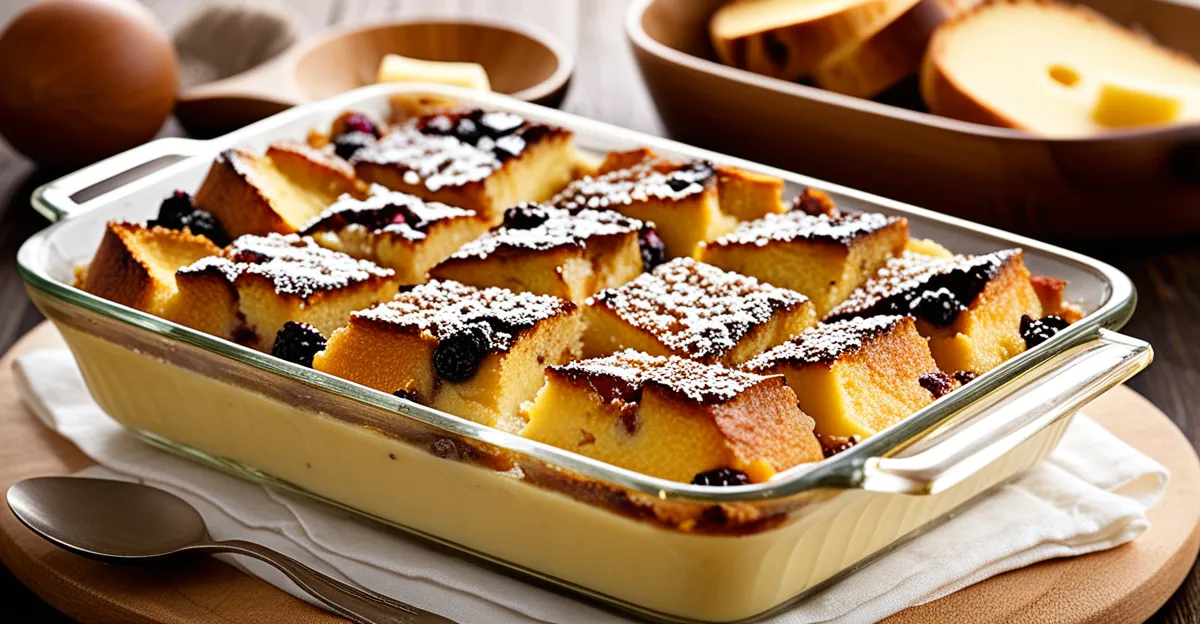Essential Ingredients for Creamy Bread and Butter Pudding
Achieving that creamy pudding texture starts with selecting the right bread and butter pudding ingredients. The backbone of any successful pudding includes fresh eggs, full-fat milk or cream, and sugar. These elements combine to create the rich custard that defines the dish’s signature creaminess.
Choosing the correct bread type is vital. Day-old brioche, challah, or white sandwich bread absorb the custard well without becoming overly soggy. These breads’ soft crumb and slight sweetness enhance the pudding’s mouthfeel. Avoid dense or heavily textured breads, which may hinder the creamy consistency.
Additional reading : What are the tips for making a delicious steak and kidney pie?
Butter is another essential component: spreading it on each slice adds flavor and prevents the bread from soaking up custard too quickly, ensuring each bite remains tender but holds structure.
For those wanting to elevate the recipe basics, optional flavor enhancers such as vanilla extract, cinnamon, or raisins can be folded in. These add depth without overshadowing the classic creamy bread and butter pudding experience.
In the same genre : How can you elevate your Sunday roast with modern techniques?
In sum, mastering these core ingredients lays a solid foundation for a luscious and indulgent dessert that delivers on texture and taste.
Step-by-Step Preparation Process
Successful bread and butter pudding starts with a precise preparation method. First, butter each slice generously. This not only infuses richness but forms a barrier that slows custard absorption, preventing a soggy texture. Layer the bread slices neatly in the dish, ensuring gaps are minimized so the custard permeates evenly.
Next comes custard preparation—combine eggs, full-fat milk or cream, and sugar until smooth. Pour this mixture slowly over the bread layers, allowing the liquid to soak in. The question often arises: How long should the custard soak? For maximum creaminess, let the pudding sit for at least 20 minutes before baking. This resting time lets the bread fully absorb the custard without collapsing.
Proper soaking is key to a luscious texture. Insufficient soaking leaves dry spots; too long may cause sogginess. Watching the custard level as it seeps in helps gauge readiness — if fully absorbed with no puddles, it’s time to bake. This step-by-step guide ensures your pudding develops its signature creaminess by balancing custard absorption and bread integrity.
Tips for Achieving Extra Creaminess
Mastering how to make pudding creamy involves careful attention to dairy selection and custard consistency. Using a combination of full-fat milk and cream balances richness and texture, creating a custard thick enough to coat the bread without becoming heavy. For the best results, aim for a ratio of roughly two parts milk to one part cream, which enhances the luscious mouthfeel essential to a creamy bread and butter pudding.
When mixing the custard, whisk gently but thoroughly to dissolve the sugar and fully incorporate the eggs. Avoid overbeating, as this can introduce excess air, leading to bubbles that disrupt the smooth creamy texture.
Resting and soaking times profoundly impact the pudding texture secrets. Allow the soaked bread to rest for about 20 to 30 minutes before baking; this ensures the custard has permeated evenly throughout all the layers. This step improves custard absorption and prevents dry patches, a common issue in dry or uneven puddings. Paying close attention to these creamy bread and butter pudding tips helps secure a tender, indulgent dessert that delights with every spoonful.
Baking and Serving Recommendations
Perfecting bread and butter pudding baking time ensures the ideal custard set and creamy texture. Bake at a moderate temperature—around 160°C (320°F)—for roughly 40 to 50 minutes. This allows the custard to gently firm without drying out or curdling. Oven hot spots can cause uneven cooking, so rotating the dish midway helps achieve a uniform bake.
How do you know when the pudding is perfectly cooked? The top should be golden and slightly crisp, while a skewer inserted in the center emerges with minimal moist custard clinging. If the skewer comes out covered in wet custard, baking needs more time. Conversely, a dry skewer indicates overcooking.
Serving bread and butter pudding is as essential as baking it right. Let the pudding rest a few minutes post-oven; this helps it set further and makes slicing easier. Offering accompaniments like warm custard sauce, cream, or vanilla ice cream enhances the indulgence, creating a delightful contrast to the soft, creamy pudding. These few adjustments bring clarity to baking and serving, turning your pudding into a memorable treat.
Troubleshooting and Frequently Asked Questions
When facing common issues with bread and butter pudding, precise troubleshooting is essential. If the pudding turns out runny, it often means the custard was undercooked or the soaking time was excessive, causing the bread to become overly saturated. To fix this, increase the bread and butter pudding baking time slightly, ensuring the custard sets firmly but remains creamy. Conversely, a dry pudding usually results from baking too long or using low-fat milk, which lacks sufficient richness to keep the texture moist.
One frequent question is, “How can I prevent sogginess while keeping the pudding creamy?” The answer lies in buttering each bread slice thoroughly before layering, which slows excessive custard absorption. Also, let the custard soak for around 20 minutes—not too long—to strike the right balance.
For storage, cool the pudding completely, cover tightly, and refrigerate for up to three days. To reheat, warm gently in an oven at low heat to avoid curdling or drying out. These bread and butter pudding tips secure consistent, indulgent results and help you master any hiccups while preserving the luscious texture you desire.









